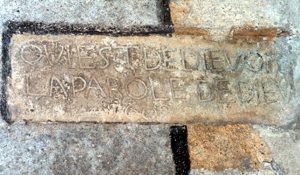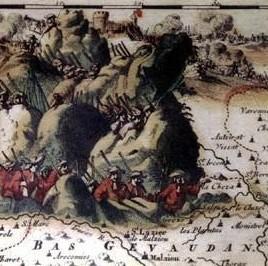His childhood in the Cévennes
Élie Marion was born at Barre des Cévennes (Lozère) in 1678 in an influential family. He was 7 years old when the Revocation of the Edict of Nantes was pronounced. He was therefore obliged to attend a school run by the parish priest but, as he mentions it in his memoirs, in the evening at home his parents did away with Catholic teachings.
He studied law in Nîmes and in Toulouse. He repeatedly thought of joining the Refuge movement. But in 1702 he became acquainted with« prophetism » and this was to change his life.
A prophet and camisard
On 1 January, 1703, Élie Marion had a mystic and prophetic illumination. He joined the troops under the camisard leader la Valette. In 1704 he became one of the camisard leaders and was appointed secretary for the troops. His prophetic action was limited.
After Jean Cavalier’s surrender, in 1704, Élie Marion kept fighting with a handful of camisards. But he was defeated and negotiated their surrender with the military authorities. In 1705 he was exiled to Switzerland, and in 1706 went to London with a few comrades.
The founder of the « French prophets »
It was in Lausanne and a little later in London that the camisard prophets’ message became millenarian, heralding Christ’s coming and his reign for a thousand years. It was similar to the puritans’ message in England. Along with a few fellow camisards Élie Marion started prophesying and attracted numerous eager people to London. He became the leader of the movement “God’s children” (“enfants de Dieu”) also the so-called « French Prophets ».
Some French people gathered in writing the « inspirations » of the prophets, notably Maximilien Mission who in 1707 published these testimonies entitled Sacred theatre in the Cévennes (Théatre sacré des Cévennes). This work was immediately translated into English. At the same time Marion also published his prophetic warnings (avertissements prophétiques). The books had much success and brought numerous English personalities to the movement.
The French church in London, however, condemned the prophets and refused to give them the Lord’s Supper. The resulting quarrels were the talk of London in 1707 and 1708. A battle of pamphlets and libels followed with more than 150 publications. Riots broke out against the prophets. Marion’s prophetic warnings were condemned by a judge as being seditious. Newspapers all over Europe reported on this as, for instance, Pierre Bayle in his News of the Republic of Letters (Nouvelles de la République des Lettres), publishedin the Netherlands.
The spreading of such news attracted numerous adepts and an increasing agitation was noticeable. The false claims of a resurrection resulted in the split up of the group. Marion tried to reunite it by establishing a system of organisation and a hierarchy.
Marion's tour in Europe (1711-1713)
The « French prophets » began missions outside London. English followers would travel all over England, Ireland and Scotland. Marion and a few comrades were to bring the « Spirit’s message » (« message de l’Esprit ») to Europe.
In 1711 they were warmly welcomed in Germany by the German pietists in Halle, Leipzig and Erlangen. But the Lutheran and Calvinist clergy showed hostility. The prophets were sent away or threatened with prosecution. The second journey, to Stockholm in 1712-1713, was a total failure. While travelling through Poland they were arrested and jailed for two months. In prison Marion had a fever. When freed he was still sick but went on to Halle, to Moravia and Constantinople. The prophets sent messages to the sultan and to the king of Sweden imprisoned in Constantinople, but to no avail. They boarded a ship to Italy and went to Rome. But Marion, at the age of 35, was to die on the way there on 28 November, 1713.









